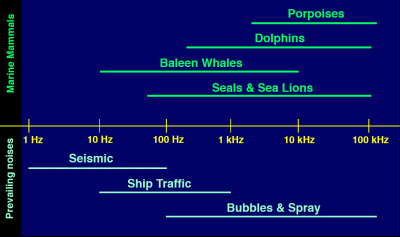Tutorial: Masking
Highlights: Masking
Masking occurs when a loud sound drowns out a softer sound or when noise is at the same frequency as a sound signal. This is of particular concern to marine animals when the noise is at frequencies similar to those of biologically important signals, such as mating calls. Because of the widespread nature of anthropogenic activities, masking may be one of the most extensive and significant effects on the acoustic communication of marine organisms today.
Masking occurs when a loud sound drowns out a softer sound or when noise is at the same frequency as a sound signal. Masking is also influenced by the amount of time that the noise is present. Just as it can be difficult to hear someone talking at a loud party, elevated noise levels in the ocean may interfere with marine animals’ ability to hear important sounds. Both natural (e.g., snapping shrimp) and anthropogenic (e.g., shipping noise) sound sources can increase the level of background or ambient noise in the environment. Masking occurs when noise interferes with a marine animal’s ability to hear a sound of interest. The masking effect is most pronounced when the loud sound is at the same frequency as the softer sound. This is of particular concern to marine mammals when the noise is at frequencies similar to those of biologically important signals, such as mating calls (for more information on frequency ranges of underwater sounds, please see What are common underwater sounds?). The masking effect is also influenced by the amount of time that the noise is present.

Approximate frequency ranges of marine mammals sounds and ambient noise. Masking is of particular concern to marine mammals when the noise is at frequencies that are similar to biologically important signals.
Animals may try to minimize masking by changing their behavior. Just as you may talk more loudly to be heard at a party, animals may use louder calls. These behavior changes may also include producing more calls, longer calls, or shifting the frequency of the calls. A long-term study of three social groups (pods) of killer whales suggests that killer whales may change their vocal behavior once background noise reaches a threshold level. Scientists compared killer whale calls recorded in the presence and absence of boat noise at three time periods between 1977 and 2003. They found longer call durations for all three pods in the presence of boats during the 2001-2003 period. The number of whale-watching vessels increased approximately fivefold from 1990 to 2000, and the scientists suggest that the ambient noise from the increased number of boats crossed the masking threshold, causing the killer whales to change their vocal behavior.

A long-term study of three social groups (pods) of killer whales found that once boat noise became sufficiently loud to mask their normal vocalizations, killer whales increased their call duration. Image credit: NOAA, NWFSC.
In another example, the effects of noise on the vocal behavior of beluga whales in the St. Lawrence River Estuary have been studied. This region is both a main route for commercial shipping and a popular location for whale watching. Beluga whales live in the region year-round. Researchers found that when exposed to noise from a small motorboat and from a ferry, belugas reduced their calling rate as the boats were approaching, but then increased the repetition of certain calls when boats came within 1 kilometer. Beluga whales also changed the type of vocalizations and shifted to higher frequencies, perhaps in an attempt to minimize masking. Another study showed that beluga whales vocalized more loudly when exposed to higher noise levels, a reaction called the Lombard Effect. The Lombard response allows animals to cope with increased noise levels, but the animals must expend more energy in the process. There is also a limit to the Lombard response when the noise completely overwhelms the animal’s vocalizations. More research is needed to determine the noise levels at which the Lombard response begins and when the beluga vocalizations are completely masked.
There are still many uncertainties regarding how masking affects marine mammals. For example, it is not known how loud acoustic signals must be for animals to recognize or respond to another animal’s vocalizations. It is also unknown if animals listen to all the sounds they can hear or select which sounds they want to listen to. The potential impacts that masking may have on individual survival, what things marine mammals may do to avoid masking, and the energetic costs of changing behavior to reduce masking are poorly understood. However, because of the widespread nature of anthropogenic activities, masking may be one of the most extensive and significant effects on the acoustic communication of marine organisms today.
References
- Foote, A.D., Osborne, R.W. and Hoelzel, A.R. 2004, “Whale-call response to masking boat noise.” Nature 428(29 April 2004): 910.
- National Research Council. 2003, “Ocean Noise and Marine Mammals.” The National Academies Press, Washington, D.C.
- Scheifele, P.M., Andrew, S., Cooper, R.A., Darre. M., Musiek, F.E., and Max, L. 2005, “Indication of a Lombard vocal response in the St. Lawrence River beluga.” Journal of the Acoustical Society of America 117(3): 1486-1492.